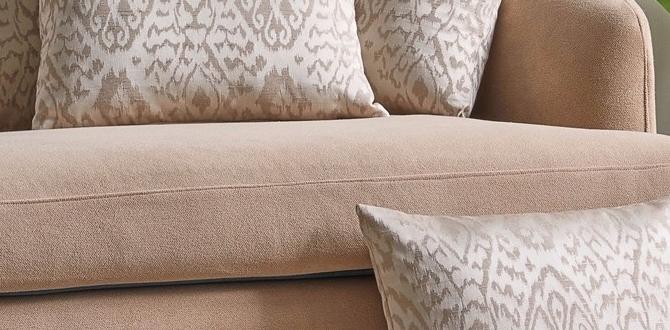Essential garden edging and borders define your outdoor space, prevent plant encroachment, and add a polished, professional look. Learn simple, budget-friendly ways to create beautiful, functional edges that elevate your garden’s style.
Garden Edging & Borders: Your Secret Weapon for a Stunning Yard
Ever feel like your garden beds are staging a friendly takeover of your lawn, or the path you walk is getting a little… wild? You’re not alone! Keeping plants neatly in their place while making your garden look intentionally designed can be a puzzle. But what if I told you there’s a simple, often affordable trick to instantly make your garden look more put-together and professional? It’s all about garden edging and borders! These simple lines do more than just keep things tidy; they frame your beautiful plants, prevent grass from creeping into your flowerbeds, and add a fantastic design element. Ready to transform your garden from “a bit messy” to “absolutely gorgeous? Let’s dive in and discover how easy it is to create stunning garden edges.
Why Garden Edging Matters: More Than Just a Pretty Face
Think of garden edging as the frame around a beautiful piece of art. Without a frame, the painting might look unfinished or even a bit lost. Garden edging does the same for your landscape. It provides a crisp, clean line that separates different areas – like your lawn from your flowerbeds, or your winding pathways from the surrounding greenery. This visual separation makes your garden look more organized and intentional.
But it’s not just about looks! Edging serves practical purposes too:
Keeps Grass Out: This is a big one, especially if you have a lawn. Without a barrier, grass loves to creep into garden beds, making them look overgrown and requiring constant weeding efforts.
Prevents Soil Erosion: In sloped areas, edging can help hold soil in place, preventing it from washing away during heavy rain and protecting valuable topsoil.
Defines Pathways: Clear edges make your garden paths safer and easier to navigate, guiding visitors through your beautiful space.
Enhances Drainage: Some types of edging can help manage water flow, improving drainage in your garden beds and preventing waterlogging.
Adds a Professional Touch: Even the simplest garden can look like it was professionally landscaped with well-defined edges.
Choosing Your Garden Edging Style: What’s Your Vibe?
The best part about garden edging is the sheer variety! You can choose materials and styles that perfectly match your home’s architecture, your personal taste, and your budget. Let’s explore some popular options.
Natural & Organic Edging
These options blend seamlessly into the natural landscape and are often made from organic materials or look like they are.
No Edging (The “Wild” Look): For a very natural, informal garden, especially in cottage or wild-flower style gardens, you might choose to forgo traditional edging. The key here is to maintain very neat lines with a spade or trimmer, creating a soft, almost invisible border. It requires diligent maintenance to keep it looking intentional rather than neglected.
Mushroom/Stone Borders: Sourcing natural stones or reclaimed brick can create a charming, rustic border. These can be laid flat, slightly embedded, or stacked. The informal nature of these materials offers a soft, earthy feel.
Wood Edging: Landscape timbers, split logs, or even sturdy branches can create a rustic and warm border. They are relatively easy to install but will eventually decompose, requiring replacement. Ensure you use rot-resistant wood if possible.
Formal & Structured Edging
These materials offer clean lines and can define spaces with a more sophisticated or modern feel.
Pavers & Bricks: Laid end-to-end and slightly sunk into the ground, pavers or bricks create a classic, durable edge. You can choose from various colors and styles to match your hardscaping. For a more permanent and professional look, consider using a landscape adhesive to secure them.
Metal Edging: Aluminum or steel edging offers a sleek, modern, and incredibly durable solution. It’s unobtrusive, allowing plants to flow right to the edge, and is excellent for creating smooth curves. It’s a favorite for a reason – it’s virtually maintenance-free and lasts for years. You can find guides on installing this at resources like the Metal Edging Installation Guide.
Stone Slabs or Forms: Larger, flat stones or pre-cast concrete forms can create a more substantial, architectural border. These are excellent for modern designs or to create raised beds.
DIY & Budget-Friendly Edging
Want a beautiful edge without breaking the bank? Here are some creative options.
Recycled Materials: Old bottles (wine or beer!) can be buried neck-down to create a colorful, whimsical border. Old tires, cut in half and buried, can also offer a unique look, though care should be taken regarding potential leaching of chemicals into the soil – research this thoroughly for your specific use.
Gabion Walls: Wire cages filled with local stones create a modern, industrial-chic border that also offers drainage and habitat for beneficial insects.
Woven Willow or Bamboo: For a natural, bohemian look, consider weaving flexible branches like willow or bamboo into a border. This is a more temporary solution but adds a wonderful texture.
The Top Edging Materials: Pros, Cons, and Considerations
Deciding on the right material is a key step. Here’s a quick rundown to help you compare:
| Material | Pros | Cons | Best For |
|---|---|---|---|
| Plastic/Vinyl Edging | Inexpensive, flexible, easy to install, weather-resistant | Can become brittle over time, may look less natural, can be less durable | Beginners, curved beds, budget projects |
| Metal (Steel/Aluminum) | Extremely durable, sleek, modern look, virtually maintenance-free, unobtrusive profiles | Higher upfront cost, can be trickier to install on very uneven terrain | Modern designs, geometric shapes, long-term investment |
| Wood (Timbers, Stakes) | Natural look, readily available, can be rustic or formal depending on wood type and finish | Will eventually rot (unless treated or rot-resistant), requires eventual replacement, can harbor insects | Woodland gardens, rustic landscapes, natural aesthetics |
| Stone/Brick/Pavers | Durable, adds weight and permanence, classic aesthetic, wide variety of styles | Can be labor-intensive to install, higher cost, can be challenging for curves | Formal gardens, manicured lawns, pathways, patios |
| Recycled Materials (Bottles, Tires) | Very inexpensive, eco-friendly, unique and creative potential | Durability can vary, aesthetic might not suit all gardens, potential environmental concerns (tires) | DIY enthusiasts, quirky gardens, upcycling projects |
Designing Your Garden Borders: A Step-by-Step Approach
Now that you know your options, let’s get down to designing and installing your garden edges. It’s simpler than you might think!
Step 1: Plan Your Layout
Before you dig, grab a garden hose, stakes, string, or even spray paint.
Visualize: Walk around your garden and visualize where you want your edges to go. Do you want to define a new flower bed around a tree? Create a clear boundary between your lawn and a new vegetable patch? Separate a walkway?
Sketch It Out: A quick sketch on paper can help you see how your edges will look and how much material you might need. Consider simple curves for a natural look or straight lines for a formal design.
Mark It Out: Use your garden hose or spray paint to lay out the desired line on the ground. This is your chance to “try on” different shapes and curving before any permanent decisions are made.
Consider the Flow: Think about how people will move through your garden. Ensure your chosen edge design doesn’t create awkward turns or narrow passages where they aren’t needed.
Step 2: Choose Your Material Wisely
Refer back to our material guide. Consider these factors:
Budget: Some materials are much more expensive than others, both in terms of product cost and installation labor.
Durability & Maintenance: How long do you want it to last? Are you willing to do regular upkeep?
Aesthetic: Does it fit with your home and garden style?
Ease of Installation: Are you a DIY pro or a beginner? Some materials are much easier to work with than others.
Soil Type & Drainage: Will the material compact easily? Does it allow for good drainage?
Step 3: Prepare the Area
This is crucial for a long-lasting, professional-looking edge.
Clear the Zone: Remove any existing grass, weeds, or debris from the area where your edge will be installed. A sharp spade or edging tool is your best friend here.
Dig a Trench: The depth and width of your trench will depend on the material you choose.
For thin materials like metal or plastic edging, a trench about 3-4 inches deep and wide is usually sufficient.
For heavier materials like bricks or stones, you might need a deeper trench, sometimes with a gravel base for stability. Digging a trench that’s deep enough to bury at least half of your edging material will ensure it stays securely in place.
Level the Trench: Try to make the bottom of the trench as level as possible. This will make installation much easier and ensure your edge looks consistent.
Step 4: Install Your Edging
This is where your design comes to life!
Follow Manufacturer Instructions: If you’ve chosen a specific product, always refer to its installation guide.
Curves: For flexible materials like metal, plastic, or even wood, gently bend them to follow your marked curve. You might need stakes or connectors to help hold the shape. For rigid materials, you might need to make small cuts or use individual pieces to create a segmented curve.
Straight Lines: Use a level to ensure your edging pieces are straight and at a consistent height.
Securing Edging:
Plastic/Metal: These often come with stakes. Hammer them through the edging into the ground every few feet to keep it rigid.
Brick/Stone/Pavers: Place them firmly in the trench. You may want to tamp them down with a rubber mallet. For added stability, especially on slopes, consider using landscape adhesive or even embedding them in a shallow concrete footing for a permanent solution.
Wood: Posts or stakes can be sunk into the ground behind timbers to hold them in place.
Step 5: Backfill and Finish
Once your edging is in place, it’s time for the final touches.
Fill the Trench: Backfill the trench around the bottom of your edging material with soil. Tamp it down firmly.
Add Mulch or Soil: Now you can fill your new garden bed with soil and top it off with mulch. The edging will help keep the mulch contained and give your garden that instantly polished look.
Water and Observe: Water your new bed and check your edging to ensure it’s stable and looks as you planned.
Creative Garden Borders for Inspiration
Sometimes, seeing what others have done can spark your own ideas!
The “Recessed Trench” Method: This is a super simple and budget-friendly technique. You simply dig a trench about 6-8 inches deep and 4-6 inches wide all around your garden bed. The clean, sharp edge of the trench itself acts as the border, keeping grass at bay and providing a visual break. Keep the sides of the trench neat with regular string-trimming. You can see an example of this effective method discussed on gardening forums and even university extension sites for its practicality.
Gabion Wall Borders: Imagine sleek, modern wire baskets filled with beautiful local river stones or colourful recycled glass. These gabion walls can be low or tall, defining beds, retaining walls, or simply acting as striking decorative elements. They offer excellent drainage and a unique, textural contrast.
Living Edging: For the truly eco-minded and patient gardener, consider planting a low-growing, dense shrub or a collection of herbs along the edge of a bed. Lavender, low-growing boxwood, or creeping thyme can form a fragrant, living border that doubles as habitat for pollinators. This requires more planning and ongoing trimming but offers a beautiful, natural appeal.
Curved Brick Paths with Integrated Edging: Consider running a path of bricks or pavers into your garden beds. The edge of the path itself can transition seamlessly into a low border, creating a flowing, integrated design that seamlessly connects different garden zones.
Maintaining Your Garden Edges
No matter what material you choose, a little regular maintenance will keep your edges looking sharp:
Tidy Up: A quick sweep or blast with a leaf blower after mowing the lawn will keep grass clippings and debris off your edges.
Weed Wisely: Any weeds that do manage to sprout near the edge should be pulled promptly.
Check for Stability: Periodically, especially after heavy rain or frost, check your edging to ensure it hasn’t shifted or loosened. Make any necessary adjustments.
Refresh Materials: Wood will need eventual replacement. Cracks in stone or brick may need filling. Plastic can become brittle. Keep an eye on the condition of your chosen material and be prepared for its lifespan.
Frequently Asked Questions About Garden Edging
Q1: What’s the easiest type of garden edging for a beginner?
A1: For absolute beginners, the recessed trench method (simply digging a clean, deep trench) is the easiest and most budget-friendly. For a more defined look, flexible plastic or vinyl edging with stakes is also very simple to install, especially for curved beds.
Q2: How deep should I dig my garden edge trench?
A2: For a simple trench edge, aim for 6-8 inches deep. For materials like plastic or metal, a 3-4 inch deep trench is often enough to hold the base securely, with a few inches of the material showing above ground. For heavier materials like bricks or stones, dig deeper to accommodate the material plus a stable base (sometimes 6 inches or more).
Q3: Can I use garden edging on a slope?
A3: Yes, but it requires careful planning. For slopes, sturdier materials like stone, brick, or metal are often better as they can be more securely installed and can help with retaining soil. Stepped edging (using different heights of material) can also be effective on moderate slopes. Ensure you’re not creating a water catchment issue.
Q4: How do I keep grass from growing through my garden edging?
A4: Proper installation is key. Ensure your edging is buried deep enough to create a physical barrier. For lawn edges, the goal is to have the top of your edging sit slightly above the lawn level. Regular maintenance – like trimming the lawn edge with a string trimmer or edger tool – will also prevent grass from creeping over the top.
Q5: What is the most natural-looking garden edging?
A5: Materials like natural stone, wood (especially reclaimed or rustic timber), or a well-maintained recessed trench tend to look the most natural. Living edgings using low shrubs or herbs also blend beautifully into the landscape.
Q6: Can garden edging help with drainage?
A6: Some types can. For example, a dug trench with gravel can improve drainage. Gabion walls, filled with porous stone, also allow water to pass through. However, solid edging materials like poured concrete or tightly fitted bricks can sometimes impede drainage if not installed with proper grading or drainage systems.
Q7: How often do I need to replace garden edging?
A7: This depends entirely on the material! Well-installed metal or stone edging can last decades. Wood may last 5-15 years depending on the type and treatment. Plastic can degrade in sunlight over 5-10 years. Recycled materials vary greatly. Regular inspection means you can address issues before they become major problems.
Tying It All Together: Your Beautifully Defined Garden Awaits
Creating garden edging and borders is one of the most impactful yet accessible ways to elevate your outdoor space. It’s about more than just neatness; it’s about intentional design, plant protection, and adding that professional polish that makes your garden a true sanctuary. Whether you opt for the rustic charm of wood, the sleek modernity of metal, the classic appeal of brick, or the simplicity of a well-dug trench, the process is rewarding. Remember, start with a plan, choose materials that suit your style and your capabilities, prepare your area thoroughly, and install with care. With a little effort, you’ll gain a garden that not only looks stunning but is also easier to maintain, inviting you to spend more time enjoying the beauty you’ve created within its defined borders. Happy gardening!





